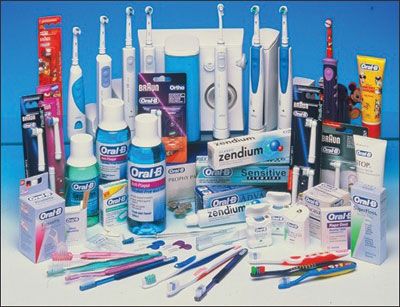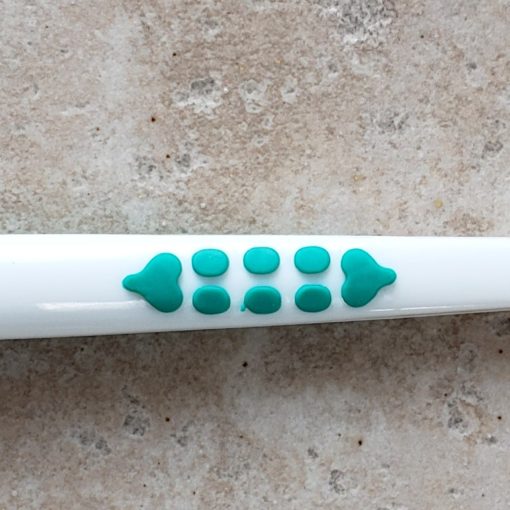NIGHT GUARDS
Night guards are used to buffer the force and pressure of grinding and clenching. Grinding also called bruxism is the back and forth movement of the jaw usually with a lot of pressure and intensity — tends to be loud and sounds like chewing on gravel. Clenching is clamping the teeth together firmly and tightening the jaw muscles — tends to be usually silent. When we grind and clench, we can put up to 250 pounds of pressure per square inch on our teeth whereas, when we chew, we put up to about 25-40 pounds of pressure. A night guard will absorb some of that pressure where ideally you wear the night guard down rather than your teeth. It’s a lot easier and cheaper to replace a night guard than it is your teeth.
Night guards are usually made for the upper arch, although they can be made for the lower arch if that’s more comfortable.
Nightguards shouldn’t be confused with sports guards. A sports guard is used while playing sports to protect the teeth as much as possible to shock. A different blog will be written on sports guards.
Types of night guards
Stock mouth protector. A generalized fit — this type comes ready to wear. They can be bulky and rigid. If your handy they can be “adjusted” with tools, knives or scissors to fit better. In my experience some people tolerate these well and some people want nothing to do with them. Keep in mind since these night guards are not a custom fit, they can irritate the Temporomandibular Joint (TMJ) — the hinge joint that connects the lower jaw to the skull and assists in opening and closing the mouth. If you start to notice (more) discomfort in the TMJ area QUIT using this device, you don’t want to cause more or different issues. This type isn’t highly recommended from the dental field for the reasons of not being a good fit and risks of causing other mouth issues: TMJ pain, mouth pain, tissue pain since ill-fitting appliances can rub and cause sores. Mouth guards are usually made with acrylics.
Boil and Bite. This type of night guard forms to the teeth better than the stock night guards. With these type of night guards definitely follow the instructions with how to heat them up by microwaving, placing in hot water, or boiling. Then place in the mouth and it conforms to the teeth. The boil and bite are made from thermoplastic materials.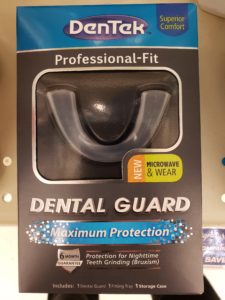
Custom fit. These night guards are the best fit as the name states they are custom. Impressions are taken at the first appointment usually about a 20-minute time frame. The impressions are usually sent to a lab, although some dentists make them in their own office. The second appointment is to try in the night guard to make sure it fits, usually about a 10-minute time frame. These night guards have the tooth grooves within it, like a whitening tray but thicker, so they can act as a retainer also.
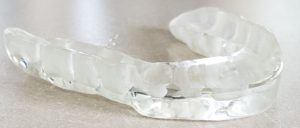
Wearing a night guard
Night guards can be challenging to get acclimated to. I have found if ortho was previously worn, a night guard is easier to get accustomed to. Due to having the experience of the discomfort of years of a mouthful of appliances. Common issues can be where the next morning the night guard ends ups under the pillow, on the floor, on the night stand or way across the room. It could take a while to get used to wearing a night guard, if that’s the case try wearing it in small increments. Put it in 10-15 minutes here and there throughout the day. Before going to bed pop it in the mouth about 20 minutes before bed. That way the brain and the tongue get used to the new object. When anything is different in the mouth the tongue goes crazy playing with it and the mind takes a few minutes to actually figure out what’s going on.
Replacement depends how aggressive the grinding is. I have seen patients having to replace them every 1-2 years, and on the contrast, I have seen patients have them for 10+ years.
Night guard care
Brush and clean with water. soak in a denture cleaner. Saliva will start to collect on it and make it look “gross”. Soaking it in a combination of bleach and water every so often will help kill the bacteria.
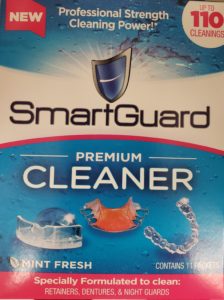
KEEP AWAY FROM DOGS, for some reason dogs like to chew on them.






